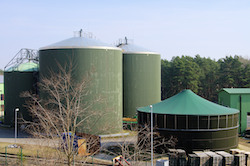Microwave treatment for enhanced biogas production from pig slurry
In Europe, rearing pigs profitably is becoming more difficult for farmers. Animal feed costs have risen significantly, coupled with lowered meat prices fetched at market. Additionally, regulations and targets in place for environmental and waste management, compound the problem because while controlling pollution and contamination, they leave farmers with less economical uses for slurry. And as pig herds are constantly growing, so the amount of slurry is quickly reaching crisis point. If pig farmers are to remain in business and improve their margins, they need an innovation capable of turning this challenging situation into an opportunity. The biowave project has shown leadership in this area by developing at commercial scale, a microwave treatment system for enhanced biogas production from pig farm slurry. Project trials have demonstrated an improvement in biogas production of over 40 % compared to untreated slurry. The EU-funded support has enabled the team to market the technology to investors: large scale biogas operators (including farmers) and technology integrators. Microwave pre-treatment technology for biogas Pig manure is typically used as an organic fertiliser for crop land or as a feedstock for anaerobic digestion (whereby microorganisms break down biodegradable compounds in oxygen free environments), for the production of biogas. However, challenges occur in the fertiliser sector when it’s nitrate values exceed what the cropland can consume. Regarding anaerobic digestion, while a good feedstock, it typically has very low biogas potential and consequently operating a biogas plant with pig manure alone is often unviable. Making pig slurry anaerobically digestible for biogas, necessitates adding sources of organic carbon at a ratio of 8:1, rendering it uneconomical for farmers. However, biowave developed an innovative microwave pre-treatment technique that increases the compatibility of pig slurry for anaerobic digestion. Additionally, the system has great potential for enhancing biogas production from other typical feedstocks such as energy crops, cattle slurry and food waste. The biowave process converts the hard carbon in the feedstock which bacteria cannot digest, into soluble carbon, thus improving the Carbon:Nitrogen ratio and so also the total bio-available carbon for anaerobic digestion. As Mr Ken McGrath, project coordinator says, “Organic material is pumped to the system and microwave energy disrupts the cell structure within the material making it significantly more digestible – resulting in higher biogas yields and faster anaerobic digestion.” Removing the necessity to add organic material increases the biogas yield from slurry by over 40 %, offering farmers a means to utilize ever-growing amounts of slurry. Catalyst for greater adoption of anaerobic digestion in agriculture Biogas production is a key technology that can reduce energy costs, helping Europe meet its 27 % renewable energy targets by 2030(opens in new window) and more broadly contribute to the Sustainable Development Goals (SDGs)(opens in new window). Outlining further benefits McGrath says, “Given the expected food production increase until 2050, with the associated greenhouse gas emissions, we need technological advancements now more than ever and biowave can play an important part here. Agriculture will need to be a leader in climate action and we’re delighted to be directly involved.” Designed for integration with both new and existing organic waste streams, biowave carries potential for mass market adoption - a prospect the team are actively exploring within the wider agri-food industry. They are also building further reference sites, while working with prospective customers to bring the technology to market as soon as possible.







